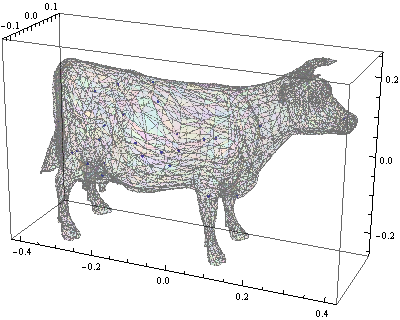This is basically a rehash of code I posted in a prior thread on this topic. The underlying method is to shoot a ray from the point and see how many surface triangles it intersects.
elsie = ExampleData[{"Geometry3D", "Cow"}];
verts =
First[Cases[elsie, GraphicsComplex[a_, ___] :> a, Infinity]]; pgons =
First[Cases[elsie, Polygon[x_, ___] :> x, Infinity]];
makeTriangles[tri : {aa_, bb_, cc_}] := {tri}
makeTriangles[{aa_, bb_, cc_, dd__}] :=
Join[{{aa, bb, cc}}, makeTriangles[{aa, cc, dd}]]
trianglevnums = Flatten[Map[makeTriangles, pgons], 1];
triangles = trianglevnums /. j_Integer :> verts[[j]];
flats = Map[Most, triangles, {2}];
pts = verts;
xcoords = pts[[All, 1]];
ycoords = pts[[All, 2]];
zcoords = pts[[All, 3]];
xmin = Min[xcoords];
ymin = Min[ycoords];
xmax = Max[xcoords];
ymax = Max[ycoords];
zmin = Min[zcoords];
zmax = Max[zcoords];
n = 30;
xspan = xmax - xmin;
yspan = ymax - ymin;
dx = 1.05*xspan/n;
dy = 1.05*yspan/n;
midx = (xmax + xmin)/2;
midy = (ymax + ymin)/2;
xlo = midx - 1.05*xspan/2;
ylo = midy - 1.05*yspan/2;
edges[{a_, b_, c_}] := {{a, b}, {b, c}, {c, a}}
vertexBox[{x1_, y1_}, {xb_, yb_, dx_, dy_}] := {Ceiling[(x1 - xb)/dx],
Ceiling[(y1 - yb)/dy]}
segmentBoxes[{{x1_, y1_}, {x2_, y2_}}, {xb_, yb_, dx_, dy_}] :=
Module[{xmin, xmax, ymin, ymax, xlo, xhi, ylo, yhi, xtable, ytable,
xval, yval, index}, xmin = Min[x1, x2];
xmax = Max[x1, x2];
ymin = Min[y1, y2];
ymax = Max[y1, y2];
xlo = Ceiling[(xmin - xb)/dx];
ylo = Ceiling[(ymin - yb)/dy];
xhi = Ceiling[(xmax - xb)/dx];
yhi = Ceiling[(ymax - yb)/dy];
xtable = Flatten[Table[xval = xb + j*dx;
yval = (((-x2)*y1 + xval*y1 + x1*y2 - xval*y2))/(x1 - x2);
index = Ceiling[(yval - yb)/dy];
{{j, index}, {j + 1, index}}, {j, xlo, xhi - 1}], 1];
ytable = Flatten[Table[yval = yb + j*dy;
xval = (((-y2)*x1 + yval*x1 + y1*x2 - yval*x2))/(y1 - y2);
index = Ceiling[(xval - xb)/dx];
{{index, j}, {index, j + 1}}, {j, ylo, yhi - 1}], 1];
Union[Join[xtable, ytable]]]
pointInsideTriangle[
p : {x_, y_}, {{x1_, y1_}, {x2_, y2_}, {x3_, y3_}}] :=
With[{l1 = -((x1*y - x3*y - x*y1 + x3*y1 + x*y3 - x1*y3)/(x2*y1 -
x3*y1 - x1*y2 + x3*y2 + x1*y3 - x2*y3)),
l2 = -(((-x1)*y + x2*y + x*y1 - x2*y1 - x*y2 + x1*y2)/(x2*y1 -
x3*y1 - x1*y2 + x3*y2 + x1*y3 - x2*y3))},
Min[x1, x2, x3] <= x <= Max[x1, x2, x3] &&
Min[y1, y2, y3] <= y <= Max[y1, y2, y3] && 0 <= l1 <= 1 &&
0 <= l2 <= 1 && l1 + l2 <= 1]
faceBoxes[
t : {{x1_, y1_}, {x2_, y2_}, {x3_, y3_}}, {xb_, yb_, dx_, dy_}] :=
Catch[Module[{xmin, xmax, ymin, ymax, xlo, xhi, ylo, yhi, xval, yval,
res}, xmin = Min[x1, x2, x3];
xmax = Max[x1, x2, x3];
ymin = Min[y1, y2, y3];
ymax = Max[y1, y2, y3];
If[xmax - xmin < dx || ymax - ymin < dy, Throw[{}]];
xlo = Ceiling[(xmin - xb)/dx];
ylo = Ceiling[(ymin - yb)/dy];
xhi = Ceiling[(xmax - xb)/dx];
yhi = Ceiling[(ymax - yb)/dy];
res = Table[xval = xb + j*dx;
yval = yb + k*dy;
If[pointInsideTriangle[{xval, yval},
t], {{j, k}, {j + 1, k}, {j, k + 1}, {j + 1, k + 1}}, {}], {j,
xlo, xhi - 1}, {k, ylo, yhi - 1}];
res = res /. {} :> Sequence[];
Flatten[res, 2]]]
gridBoxes[pts : {a_, b_, c_}, {xb_, yb_, dx_, dy_}] :=
Union[Join[Map[vertexBox[#, {xb, yb, dx, dy}] &, pts],
Flatten[Map[segmentBoxes[#, {xb, yb, dx, dy}] &, edges[pts]], 1],
faceBoxes[pts, {xb, yb, dx, dy}]]]
Here we do the preprocessing for our ray-shooting.
Timing[
gb = DeleteCases[
Map[gridBoxes[#, {xlo, ylo, dx, dy}] &,
flats], {a_, b_} /; (a > n || b > n), 2];
grid = ConstantArray[{}, {n, n}];
Do[Map[AppendTo[grid[[Sequence @@ #]], j] &, gb[[j]]], {j,
Length[gb]}];]
(* Out[163]= {3.875, Null} *)
planeTriangleParams[
p : {x_, y_}, {p1 : {x1_, y1_}, p2 : {x2_, y2_}, p3 : {x3_, y3_}}] :=
With[{den =
x2*y1 - x3*y1 - x1*y2 + x3*y2 + x1*y3 -
x2*y3}, {-((x1*y - x3*y - x*y1 + x3*y1 + x*y3 - x1*y3)/
den), -(((-x1)*y + x2*y + x*y1 - x2*y1 - x*y2 + x1*y2)/den)}]
getTriangles[p : {x_, y_}] :=
Module[{ix, iy, triangs, params, res}, {ix, iy} =
vertexBox[p, {xlo, ylo, dx, dy}];
triangs = grid[[ix, iy]];
params = Map[planeTriangleParams[p, flats[[#]]] &, triangs];
res = Thread[{triangs, params}];
Select[res,
0 <= #[[2, 1]] <= 1 &&
0 <= #[[2, 2]] <= 1 && #[[2, 1]] + #[[2, 2]] <= 1.0000001 &]]
countAbove[p : {x_, y_, z_}] :=
Module[{triangs = getTriangles[Most[p]], threeDtriangs, lambdas,
zcoords, zvals}, threeDtriangs = triangles[[triangs[[All, 1]]]];
lambdas = triangs[[All, 2]];
zcoords = threeDtriangs[[All, All, 3]];
zvals =
Table[zcoords[[j, 1]] +
lambdas[[j, 1]]*(zcoords[[j, 2]] - zcoords[[j, 1]]) +
lambdas[[j, 2]]*(zcoords[[j, 3]] - zcoords[[j, 1]]), {j,
Length[zcoords]}];
If[OddQ[Length[triangs]] && OddQ[Length[Select[zvals, z > # &]]],
Print[{p, triangs, Length[Select[zvals, z > # &]]}]];
Length[Select[zvals, z > # &]]]
isInside[{x_, y_,
z_}] /; ! ((xmin <= x <= xmax) && (ymin <= y <= ymax) && (zmin <=
z <= zmax)) := False
isInside[p : {x_, y_, z_}] := OddQ[countAbove[p]]
We'll illustrate with 10K points, chosen so that they are all in roughly the bounding box of our cow. Could perhaps be made faster with Compile but I'll leave that order of magnitude for another day.
points = Map[{.5, .15, .25}*# &, RandomReal[{-1, 1}, {10000, 3}]];
Timing[
pg = Graphics3D[
Point[points,
VertexColors -> (isInside /@ points /. {True -> Red,
False -> Directive[Opacity[0.15], Blue]})], Axes -> True,
AxesLabel -> {"x", "y", "z"}];]
(* Out[172]= {9.39063, Null} *)
Here's how it comes out.
g = Graphics3D[{Opacity[.09], EdgeForm[Opacity[.1]],
Polygon[#,
VertexColors -> Table[Hue[RandomReal[]], {Length[#]}]] & /@
Cases[Normal[elsie], Polygon[x_, ___] :> x, {0, Infinity}]},
Lighting -> "Neutral", ImageSize -> 400, Axes -> True];
Show[g, pg, AxesLabel -> {"x", "y", "z"}]




